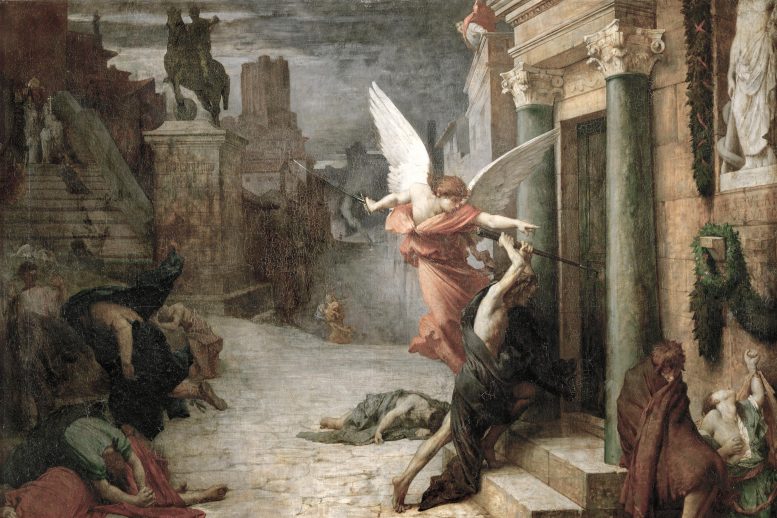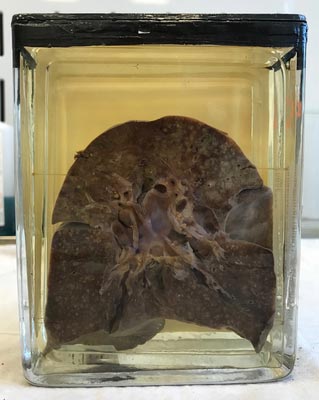
Jules-Élie Delaunay, Peste à Rome (1869). Between 165 and 180 AD, the Antonine Plague caused the death of millions of people in the Roman Empire and far beyond. This new study strengthens the hypothesis that the epidemic may have been caused by the measles virus.
The measles virus may have emerged as early as the 6th century BCE, an international team of researchers reports. The finding is based on a virus sample found in Germany that dates back to 1912. It is the oldest human RNA virus genome that has been sequenced to date. The study was published in Science.
Measles is a highly contagious infectious disease. Even though it can be prevented through vaccination, it still imposes a tremendous burden on human health. In 2018, 144,000 people died from the disease, many of whom were not vaccinated. Like many human diseases, measles originated in animals. Measles is likely the result of a spill-over of a virus from cattle to humans, which occurred after the divergence of measles and the now eradicated rinderpest virus. Estimating when these viruses shared a common ancestor helps researchers to understand how measles emerged.
The timing and circumstances of the jump from animals to humans are still debated. Previous calculations place the point of divergence in the 9th century. “We always felt this was too recent, among others because there are clear clinical descriptions of measles from this period by physicians who used earlier sources,” explains Philippe Lemey, evolutionary virologist at KU Leuven and one of the senior authors of the study. The divergence date marks the earliest possible emergence of the measles disease. “To better understand a virus, it is important to know when it started circulating,” Lemey explains.
Century-old lung
The team consisted of researchers from KU Leuven, the Robert Koch Institute, the Berlin Museum of Medical History at the Charité, the University of Oklahoma, and the University of California in Los Angeles. They analyzed a lung found in the collection of the Berlin Museum of Medical History that was preserved in formalin. The organ came from a two-year-old measles patient who died in 1912 in Berlin.
RNA molecules that make up the genomes of many viruses easily degrade, but still the team was able to assemble almost the entire measles virus genome, making it the oldest human-infecting RNA virus sequence (so far).
“We were thrilled to find that recovering viral RNA from such an old specimen was possible and, actually, quite easy to do,” says Sébastien Calvignac-Spencer of the Robert Koch Institute, whose team sequenced the genome.
Molecular clock
In a second step, the 1912 genome was added to a dataset of other genomic data from strains of the measles virus and the related rinderpest and ovine rinderpest viruses. Based on this data, the researchers reassessed the divergence date of the measles and rinderpest viruses. They did this using a new technique for advanced molecular clock modeling. “Previous estimates assume that viruses evolve a constant rate throughout time, however this new virus data supports the idea that the further back you go, the slower the evolutionary rate measurements become,” says Lemey. His team developed new models to incorporate this theory.
“The possibility to obtain viral genomes from museum samples is really exciting.” — Philippe Lemey, evolutionary virologist at KU Leuven
Their projection places the moment of divergence into the 6th century BCE, a period marked by growing populations and the rise of large cities both in Europe and Asia. Measles requires large, connected populations for undisrupted circulation, which likely did not exist prior to this period. Kyle Harper, a historian from the University of Oklahoma says. “Of course we cannot say for sure if measles emerged in humans shortly after divergence and if that was linked to demographic change, but it is certainly a plausible scenario that can no longer be excluded.”
“The oldest mentions of the measles disease date from around the 10th century, however, there are much older reports about epidemics in human and bovine populations. This study and further research will help us understand how these might be connected to the measles virus,” Lemey concludes. “The possibility to obtain viral genomes from museum samples is really exciting, and the more old samples we can sequence, the more we will learn about the history of viruses.”
Reference: “Measles virus and rinderpest virus divergence dated to the sixth century BCE” by Ariane Düx, Sebastian Lequime, Livia Victoria Patrono, Bram Vrancken, Sengül Boral, Jan F. Gogarten, Antonia Hilbig, David Horst, Kevin Merkel, Baptiste Prepoint, Sabine Santibanez, Jasmin Schlotterbeck, Marc A. Suchard, Markus Ulrich, Navena Widulin, Annette Mankertz, Fabian H. Leendertz, Kyle Harper, Thomas Schnalke, Philippe Lemey and Sébastien Calvignac-Spencer, 19 June 2020, Science.
DOI: 10.1126/science.aba9411









Be the first to comment on "Measles Virus Much Older Than Previously Thought – Genome Sequenced From Century-Old Diseased Lung"